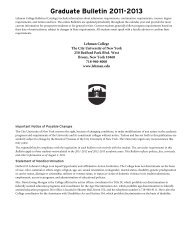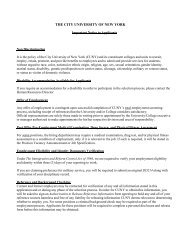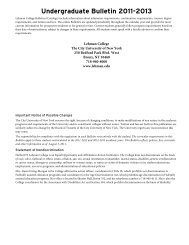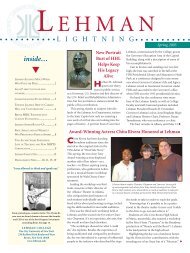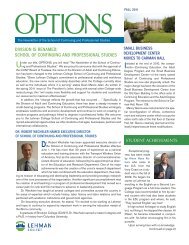Lehman Center Turns Thirty - Lehman College
Lehman Center Turns Thirty - Lehman College
Lehman Center Turns Thirty - Lehman College
Create successful ePaper yourself
Turn your PDF publications into a flip-book with our unique Google optimized e-Paper software.
<strong>Lehman</strong> <strong>Center</strong> <strong>Turns</strong><br />
There are moments when the limestone<br />
façade of <strong>Lehman</strong> <strong>Center</strong> refl ects the late<br />
afternoon sun, while catching shadows of<br />
gothic fi nials cast by the Music Building.<br />
From across the quad, the building looks like<br />
a Modernist church. But the <strong>Center</strong>, celebrating<br />
its thirtieth anniversary season this year,<br />
is perhaps more akin to a cathedral. For her<br />
part, Eva Bornstein, its executive director,<br />
speaks of the <strong>Center</strong> in religious metaphors.<br />
“On one night you have to capture twentythree-hundred<br />
souls,” she said of her mission.<br />
In a borough often eclipsed by Manhattan’s well-endowed art<br />
scene, Bornstein and her predecessors strove to fi ll the <strong>Center</strong>’s<br />
twenty-three hundred seats in boom times and bust. For years, the<br />
calendar lineup attempted to attract audiences from nearby Riverdale<br />
with mostly highbrow performances, but a programming shift<br />
in the 1990s sought to draw crowds from throughout the borough<br />
and beyond.<br />
Today, <strong>Lehman</strong> <strong>Center</strong> is running longer, fuller seasons, offering<br />
more than thirty shows with a mix of both popular and classical<br />
artists. Despite the diffi cult economy, it attracts often-record<br />
audiences, including a growing number of both families and<br />
returning visitors. As beleaguered arts centers across the country<br />
have struggled to stay afl oat, <strong>Lehman</strong> <strong>Center</strong> has managed to<br />
stay on an even keel, fi nancially as well as artistically, drawing on a<br />
12 <strong>Lehman</strong> Today/Fall 2010 – Winter 2011<br />
Photo by Jason Green<br />
Executive Director<br />
Eva Bornstein.<br />
small but dedicated staff, a valued group of corporate sponsors,<br />
and an aggressive marketing campaign that features discounted<br />
ticket packages.<br />
Investments in upgraded and expanded facilities promise future<br />
audiences an even more rewarding cultural experience. With<br />
a new $450,000 sound system already in place, thanks to an<br />
allocation from Assemblyman Jose Rivera, the <strong>Center</strong> looks forward<br />
to a new lighting system, audiovisual equipment, and other<br />
improvements made possible by a recent $850,000 allocation<br />
from Bronx Borough President Rubén Díaz, Jr. A timeline will be<br />
established shortly for a much-needed two-story addition, funded<br />
earlier through a $3.2 million allocation from the previous borough<br />
president, Adolfo Carrión, Jr., and City Council members Annabel<br />
Palma and James Vacca.<br />
Striving for Artistic Excellence Despite<br />
Financial Challenges<br />
The ongoing search for funding is nothing new in the<br />
<strong>Center</strong>’s history.<br />
By Tom Stoelker (‘09, B.A.)<br />
‘There’s an earthiness, an ease. It’s not a<br />
staid audience, and the performers love that.’<br />
A performing arts center was always considered integral to the<br />
<strong>College</strong>’s master plan. As far back as 1927, even before the campus<br />
was built for Hunter-in-the-Bronx, architects Pope and Baum<br />
proposed a theater and arts complex for $15 million (the equivalent<br />
of more than $188 million today). The Depression put a stop<br />
to that element of the building project.<br />
30<br />
A packed house greeted Ain’t Misbehavin’ at <strong>Lehman</strong> <strong>Center</strong> in 2009.<br />
<strong>Lehman</strong> <strong>Center</strong> also began in fi ts and false starts and faced<br />
fi nancial challenges. Construction began in 1973 and continued for<br />
two years until the City’s fi scal crisis in 1975 brought it to a halt.<br />
For two years, the building sat unfi nished until the State Dormitory<br />
Authority issued bonds through several local banks, and it was<br />
completed in 1980 for $50 million (in today’s dollars, about<br />
$132 million).<br />
The fi rst audience arrived on September 28, 1980, and opening<br />
night set the standard for the rest of that decade. Zubin Mehta<br />
conducted the New York Philharmonic in pieces by <strong>Lehman</strong> professors<br />
Ulysses Kay and John Corigliano. Later that season, the<br />
New York City Opera took the stage, followed by jazz legend Ella<br />
Fitzgerald, renowned violinist Itzhak Perlman, the lilting voices of<br />
the Vienna Boys Choir, and the dramatic presence of opera tenor<br />
Franco Corelli.<br />
One year after the opening, the trade journal Architectural Record<br />
praised architects David Todd and Jan Pokorny’s new building,<br />
which was just one component of a major campus-wide renovation.<br />
“Architects Todd/Pokorny have accomplished the diffi cult feat of<br />
reorganizing an outmoded, classical campus plan with sensitivity,”<br />
stated the magazine. “The enormous 2,300-seat concert hall is<br />
notable not only for its unusual size but for its fi ne acoustics—<br />
despite an unconventional fl ared plan which brings a sense of<br />
intimate contact with the stage from the farthest seats.”<br />
Considering the <strong>Center</strong>’s location right next to the day-and-night<br />
rumbles of the #4 elevated train, achieving such “fi ne acoustics”<br />
was not only miraculous but also a tribute to <strong>Lehman</strong> President<br />
Leonard Lief, who was determined to “get it right” in selecting the<br />
building’s design and materials.<br />
Dr. Valerie Washington, vice president of <strong>Lehman</strong> <strong>Center</strong>’s Board<br />
of Directors, agrees with the reviewers. For her, watching a ballet at<br />
the <strong>Center</strong> easily trumps other venues.<br />
“I was so close, as opposed to Lincoln <strong>Center</strong>, where you’re so far<br />
from the stage,” said Dr. Washington. “I don’t think there’s a bad<br />
seat in the house.”<br />
Photo by<br />
Adi Talwar<br />
<strong>Lehman</strong> Today/Fall 2010 – Winter 2011 13





